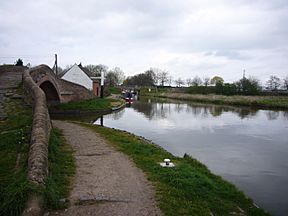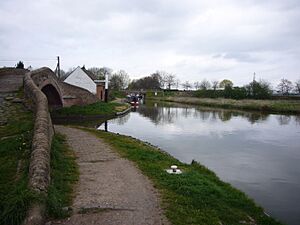Haywood Junction facts for kids
Haywood Junction, also called Great Haywood Junction, is a special place where two canals meet. It's like a watery crossroads! Here, the Staffordshire and Worcestershire Canal ends and joins the Trent and Mersey Canal. You can find this important spot near the village of Great Haywood in Staffordshire, England.
Contents
The Story of Haywood Junction
Canals were once super important for moving goods around the country. Imagine them as old highways for boats!
Building the Canals
The Trent and Mersey Canal was planned to connect two big cities: Liverpool and Hull. It also passed through an area famous for pottery. A special law was passed in 1766 to allow its building. A brilliant engineer named James Brindley designed it. The canal, which is about 93 miles (150 km) long, was finished in 1777.
Brindley also built the Staffordshire and Worcestershire Canal. Work on this canal started around the same time as the Trent and Mersey. It was finished a bit earlier, in 1772. This canal joined the Trent and Mersey Canal right here at Great Haywood.
The Grand Cross Plan
The Staffordshire and Worcestershire Canal was part of Brindley's big idea called the "Grand Cross." This plan aimed to connect four major rivers in England: the Humber, Thames, Severn, and Mersey. Because of this, Haywood Junction became a very busy place for boats and trade. It was a vital transport hub!
Exploring Haywood Junction and Nearby Sights
Haywood Junction is a fascinating place to visit, with lots to see nearby.
Canal Directions
From Great Haywood, the Trent and Mersey Canal goes north. It slowly climbs higher towards Stoke-on-Trent, where it reaches its highest point. Just south of the junction, you'll find Haywood Lock. A bit further north is Hoo Mill Lock. Locks are like water elevators that help boats move up or down between different water levels.
The River Trent flows west of the canal, but it's too small here for boats. The canal joins the River Trent about 39 miles (63 km) from the junction. The highest part of the canal begins about 18.9 miles (30.4 km) away at Etruria Lock.
Along the Staffordshire and Worcestershire Canal
The Staffordshire and Worcestershire Canal heads west from the junction. The path for walking (called a towpath) crosses over it on a bridge. Almost immediately, the canal crosses the River Trent on an aqueduct. An aqueduct is like a bridge that carries water, allowing the canal to go over a river or road.
The canal then follows the valley of the River Sow. Soon, you'll reach a wide part of the canal called Tixall Wide. It looks like a lake, but it's actually part of the canal and deep enough for boats.
Historic Buildings and Bridges
To the south of Tixall Wide is Shugborough Hall, a grand old house now looked after by the National Trust. It was started in 1695 and has been changed over the years. Inside, it has amazing plasterwork. Many buildings in its grounds are also very old and important.
Tixall Gatehouse is to the north. It's a small, eight-sided building with a stone dome. The roving bridge at the junction, which lets people cross from one side of the canal to the other without leaving the towpath, is also a historic structure.
Just south of Haywood Lock, there's a path that goes from Great Haywood to Shugborough Hall. This path crosses the River Trent on Essex Bridge. This bridge is very old, probably built in the 1500s, and is still almost exactly as it was then. It's only about 4 feet (1.2 m) wide and has fourteen arches.
Images for kids




